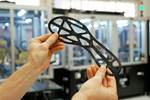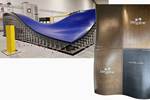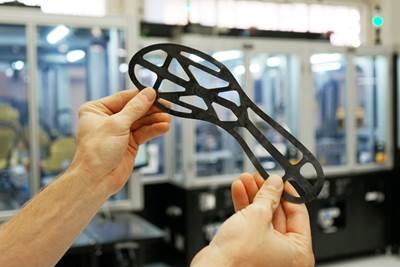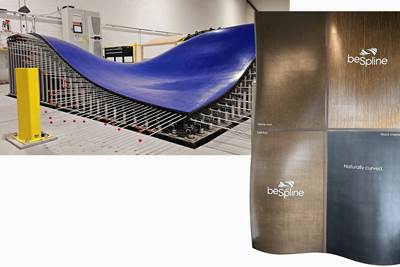Startup X-Track’s multisport tracks combine an aluminum frame, composite sandwich panels and a weatherproof rubber surface material to provide a durable, reliable alternative to traditional outdoor dirt tracks. Source (All images) | X-Track
Outdoor dirt tracks have traditionally been the norm at BMX and motocross race events, but startup X-Track (Sherbrooke, Quebec, Canada) aims to provide a cleaner, safer and longer-lasting alternative with its multi-material, modular track designs.
X-Track was founded in 2022 by Pascale Larocque, Donald Tremblay and former competitive BMX and motocross rider Steve Lussier, and came out of the Idenov Group. According to Larocque, the idea to develop and commercialize an alternative track design grew out of the recognition of issues that traditional dirt tracks present to both riders and venues. For example, riders are exposed to dust inhalation, which can pose health concerns. Dirt tracks also require a multiday installation and disposal process for dirt to be trucked in and removed, as well as constant maintenance during the event itself as vehicles carve grooves into the track. Outdoor dirt tracks are susceptible to damage from weather, and increasingly fewer indoor arenas are permitting the use of dirt tracks because of potential damage to ventilation systems and other equipment.
“We set out to develop an alternative construction that could be modular, lightweight enough to be transportable, faster and easier to assemble and disassemble, and still be durable and safe to meet rider requirements and event and safety standards,” Larocque says.
The X-Track team began investigating various materials and manufacturing methods that could be used to build a prototype track. They found that much of the structure could be made from an aluminum frame, but the curved track surfaces proved more complex, especially as these surfaces vary from track to track. Ultimately, X-Track’s team found a solution in nearby Sherbrooke composites manufacturing startup bespline. “We had originally looked at doing the track all in aluminum, but we really couldn’t do the complex and curved shapes we’ve done without composites,” Larocque emphasizes.
Bespline, founded in 2021 and co-located with sister company Addcomp, uses reconfigurable molds from Adapa (Aalborg, Denmark) to make 3D composite panels or thermoformable foam kits — without the need to build a distinct mold for each shape and part.
“We started with one very small piece of a track as a prototype, and tried a couple of different constructions,” explains Yoann Bonnefon, CEO of bespline. Essentially, bespline helped design and manufactured a curved, fiberglass composite sandwich panel cored with foam, which would be bonded to an aluminum support structure made by a manufacturing partner, and topped with a granular rubber surface material optimized for weatherproofing and for the amount of grip needed for a bike motorbike.
To manufacture each module, bespline uses Adapa reconfigurable molds (top) to make foam preforms, and to vacuum infuse near-net-shape composite sandwich panels (bottom).
First, in bespline’s typical manufacturing process, the adaptive mold is configured from the CAD file to the needed shape, and cut foam is thermoformed to create a preform — bespline markets these as Shaped Foam Kits for use by a variety of industries. Next, the preshaped foam is laid up, again on the reconfigurable mold, between fiberglass fabric skins, and cured at room temperature with liquid epoxy resin via vacuum infusion to create a composite panel with dimensions up to 6 × 10 feet. The near-net-shape panel is trimmed and then ready to be installed with the rest of the track module. Bespline also helps integrate the panel onto the aluminum structure via adhesive bonding.
After manufacturing and testing the first prototype module, bespline and X-Track worked on optimizing the panels, including reducing the thickness and trying a variety of materials, including flax fiber fabrics, bio-based epoxies from Gurit (Wattwil, Switzerland), recycled PET foam and Arkema’s (Colombes, France) Elium recyclable thermoplastic resin. “We have various material options we can use depending on what mechanical properties are required, or if they want to use bio-based or recycled materials. We have different design options such as pre-programmed shapes, and thickness and width that can be changed depending on whether it’s a track for a lighter BMX bike or heavier motocross bike,” Bonnefon says.
Composite sandwich panels are ultimately bonded between an aluminum frame an exterior rubber surface material.
How does an X-Track module perform compared to traditional tracks? “Riders’ first impression is always to be impressed by its size, and then, once they try it, by its robustness,” Larocque says. “It’s top-notch, clean, safe and thanks to the rubber surface material we use, it has a really good grip to it.”
“Rider feedback is that it feels very similar to what they’re used to riding on,” Bonnefon adds, “but with the added benefit that it is consistently the same every time. An X-Track cannot shift around after use like a dirt track can. The rider doesn’t have to constantly adjust to make up for that. Overall, it’s faster to install, easily repairable, reusable — I think it checks a lot of boxes.”
In order for its tracks to be used in competitive sport, X-Track technology is currently certified with La Fédération Québécoise des Sports Cyclistes (FQSC, Quebec Cycling Federation), and Larocque says the company is working toward certification with the Union Cycliste International (UCI) in Europe.
X-Track started trialing its track in 2023 at a professional practice site in Florida. In summer 2024, X-Track participated in the Red Bull Tennessee Knockout motorbike racing event in Nashville. X-Track provided 12 curved bump modules that were integrated into the rest of the traditional dirt track for the one-night event. “This was a great opportunity to showcase the technology, to show how much easier it is to transport and install, and their quality during competition. Any doubts have been dissipated,” Larocque says. “It also showed the option of incorporating a hybrid design, with both dirt and X-Track modules.”
X-Track is developing tracks for a variety of sports, from BMX and motocross racing, to ice cross and more. The top photo shows Bronson Pierce (left), World Supermoto Championship winner, and Nelson Jr. Moreau (right), Supermoto Quebec series champion. X-Track supplies modules for Supermoto Quebec.
Following this success, the company has begun developing not only bump modules for other dirt tracks, but full track designs for BMX and motocross, for individual competition events and permanent indoor arenas. X-Track also works with an engineering firm on customized track designs, and subcontractors for the surface material and aluminum structures.
Larocque adds that the tracks have also started attracting interest from other types of competitive bike/motorbike racing, such as for straight rhythm and pumptrack courses, and other sports, such as ice cross for competitive skating.
“There is a lot of interest, and we are building a market for our product,” Larocque says. “Part of the process is proving out the technology to show that it is worth the cost — we are competing, after all, with dirt — and to also to continue innovating our materials and technology to bring costs down where we can and continue to offer options for a variety of sports.”
Related Content
Bladder-assisted compression molding derivative produces complex, autoclave-quality automotive parts
HP Composites’ AirPower technology enables high-rate CFRP roof production with 50% energy savings for the Maserati MC20.
Read MoreCorebon induction heating
This sidebar to CW’s August 2024 feature article reviews this technology for more efficient composites manufacturing and why it aligns with Koridion active core molding.
Read MoreFyous launches infinitely reusable manufacturing mold tech
PolyMorphic Moulding technology uses 28,000 digitally controlled pins to create a shape from a 3D CAD shape in less than 20 minutes, achieving zero waste and enabling parts production 14 times faster than 3D printing.
Read MoreJamco America partners with Airtech for 3DP tool recycling
Aerospace manufacturer joins forces with composite materials company to achieve sustainable manufacturing practices that overcome traditional composite layup tooling.
Read MoreRead Next
Composites end markets: Sports and recreation (2024)
Light weight and high performance continue to make composites popular in the elite sporting good market. Sustainability in both materials and recycling solutions are a key innovation area.
Read MorePlant tour: BeSpline/Addcomp, Sherbrooke, QC, Canada
Composites automation specialist increases access to next-gen technologies, including novel AFP systems and unique 3D parts using adaptive molds.
Read MoreAll-recycled, needle-punched nonwoven CFRP slashes carbon footprint of Formula 2 seat
Dallara and Tenowo collaborate to produce a race-ready Formula 2 seat using recycled carbon fiber, reducing CO2 emissions by 97.5% compared to virgin materials.
Read More
.jpg;width=70;height=70;mode=crop)






















